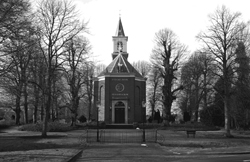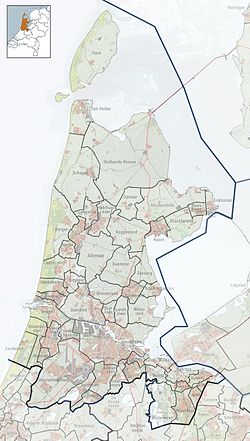Bennebroek
Bennebroek | |
|---|---|
Village | |
 Dutch Reformed church | |
| Coordinates: 52°19′N 4°36′E / 52.32°N 4.60°E | |
| Country | Netherlands |
| Province | North Holland |
| Municipality | Bloemendaal |
| Area | |
• Total | 1.81 km2 (0.70 sq mi) |
| Elevation | 1.4 m (4.6 ft) |
| Population (2021)[1] | |
• Total | 5,275 |
| • Density | 2,900/km2 (7,500/sq mi) |
| Time zone | UTC+1 (CET) |
| • Summer (DST) | UTC+2 (CEST) |
| Postal code | 2121[1] |
| Dialing code | 023 |
Bennebroek (Dutch pronunciation: [ˈbɛnəbruk] ) is a village and former municipality in the northwest Netherlands, now part of Bloemendaal, North Holland. Before its merger, it was the smallest municipality in the Netherlands, covering an area of only 1.75 km².
History
Bennebroek was probably formed in the 13th century and its development was closely linked to the peat harvesting industry.[3]
On 28 May 1653, Bennebroek split off from the Heemstede fiefdom and Adriaen Pauw, son of Adriaan Pauw, became its first feudal lord.[4] Its population was dependent on animal husbandry and transportation. Later on bulb flower cultivation became an important business here. Yet since the second half of the 20th century, Bennebroek functions primarily as a commuter community for the surrounding cities.[3]
On 29 March 2007, the municipal councils of Bennebroek and Bloemendaal agreed to merge into one municipality, which became reality on 1 January 2009.
Local government
The last municipal council of Bennebroek before its merger consisted of 11 seats, which were divided as follows:
Attractions
- Linnaeushof - a recreation park known as Europe's largest children's playground, formerly a botanical garden where Carl Linnaeus acted as hortulanus (lead gardener) in the 18th century and where he wrote the Hortus Cliffortianus
- Hartekamp - an estate (partially in Heemstede) with an extensive public park.
- Former railway station Vogelenzang-Bennebroek - railway station from 1842.
Gallery
-
Houses in Bennebroek
-
Fields of Hyacinths
-
Former town hall
-
House in Bennebroek
See also
References
- Statistics are taken from the SDU Staatscourant
- ^ a b c "Kerncijfers wijken en buurten 2021". Central Bureau of Statistics. Retrieved 28 April 2022.
- ^ "Postcodetool for 2121AA". Actueel Hoogtebestand Nederland (in Dutch). Het Waterschapshuis. Retrieved 28 April 2022.
- ^ a b "Gemeente Bennebroek History" (in Dutch). Archived from the original on 3 July 2007. Retrieved 11 December 2007.
- ^ "Gemeente Bennebroek Coat of Arms" (in Dutch). Archived from the original on 29 September 2004. Retrieved 11 December 2007.








